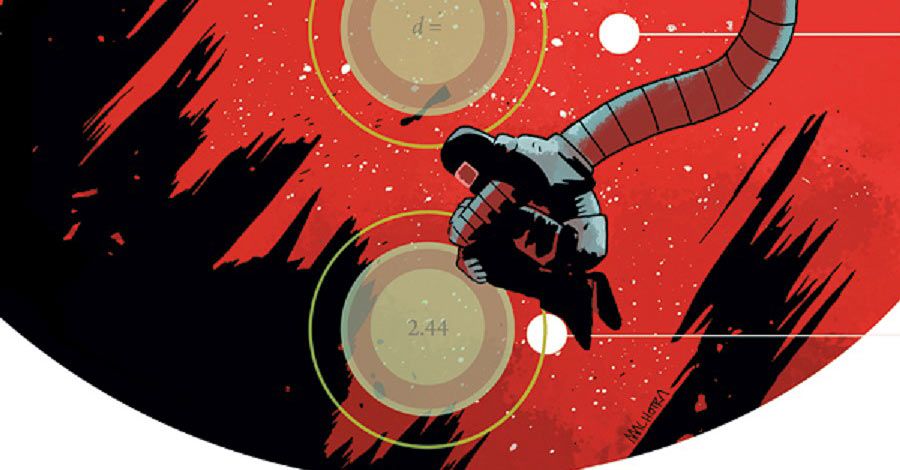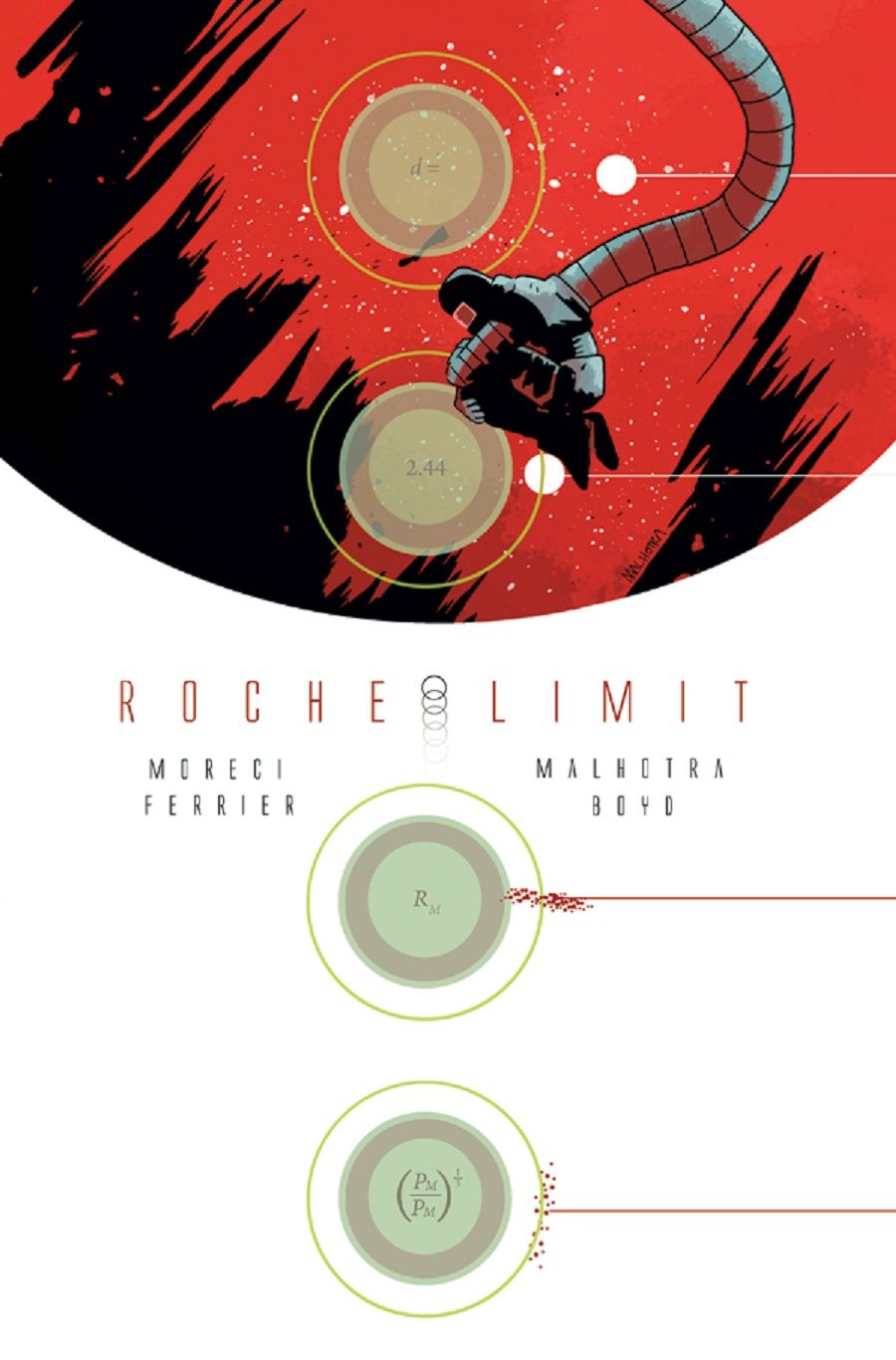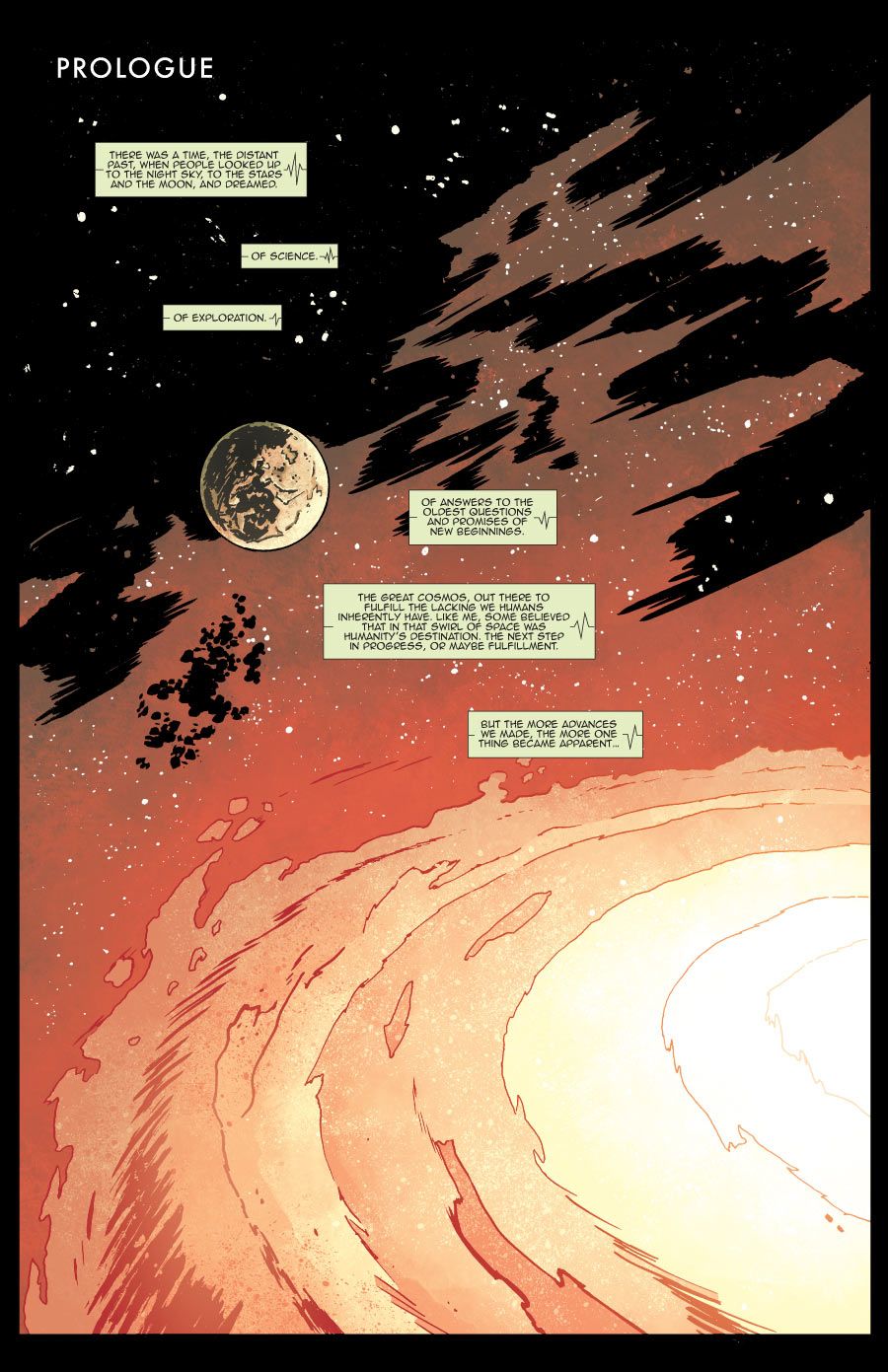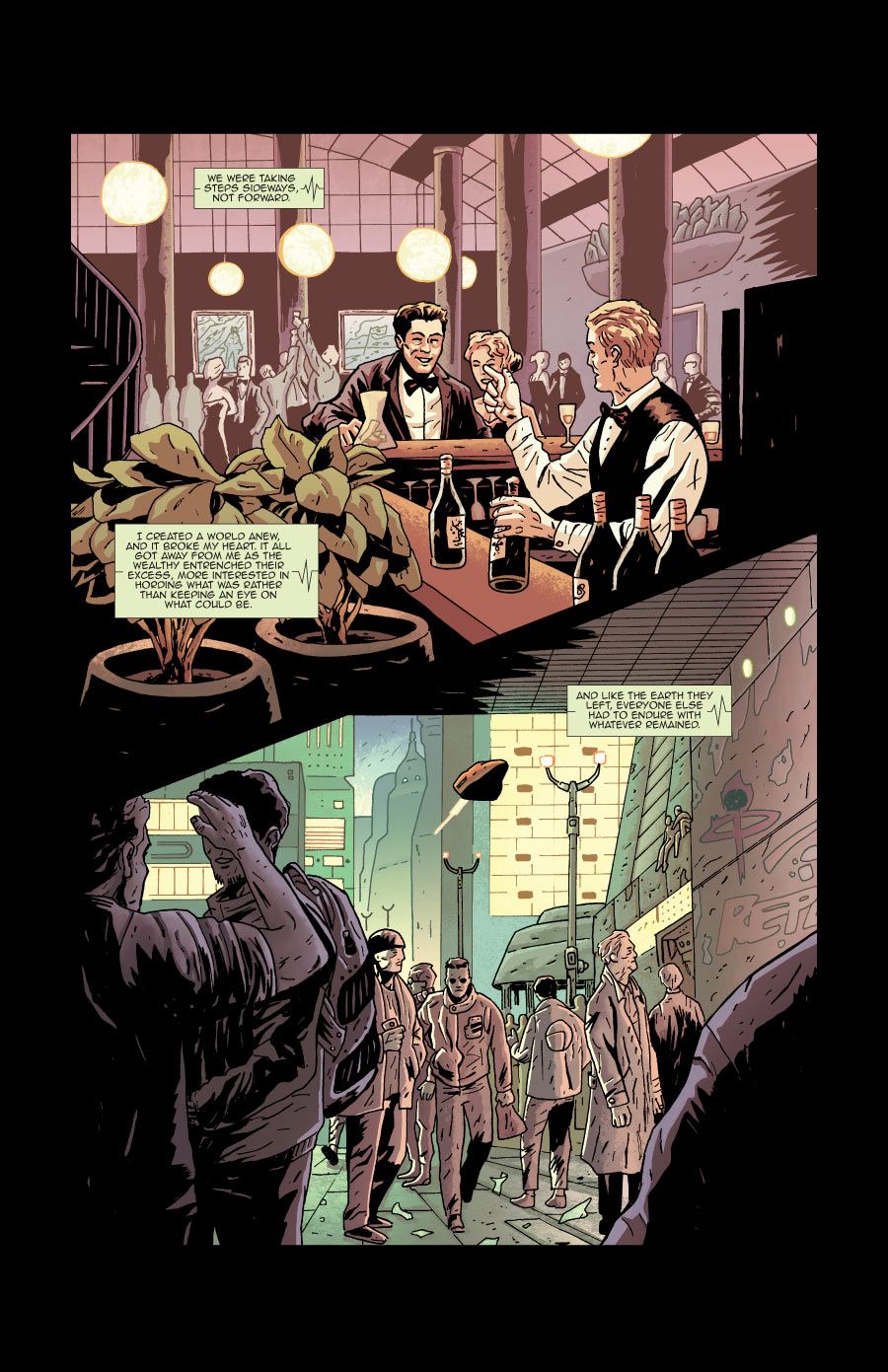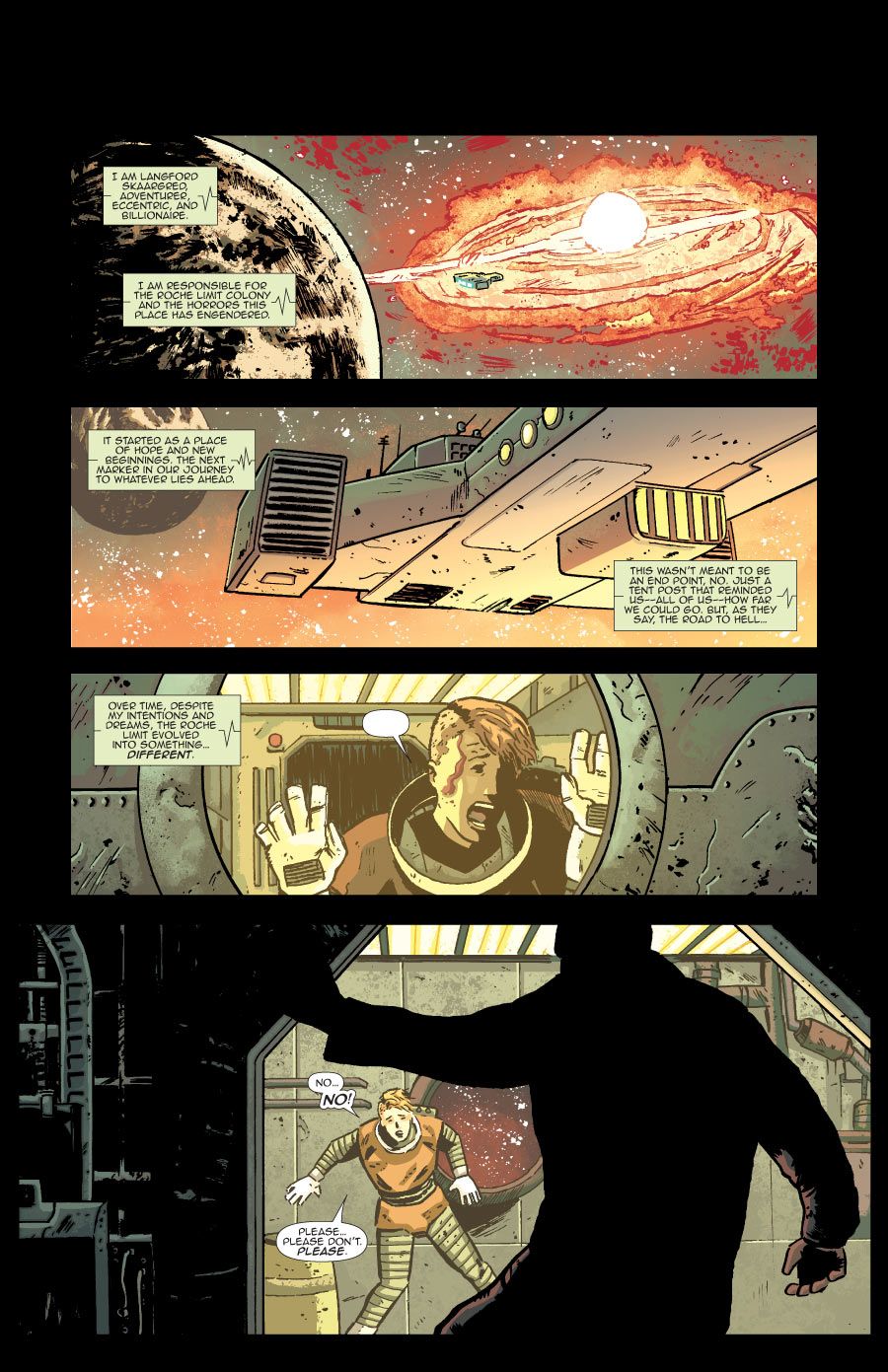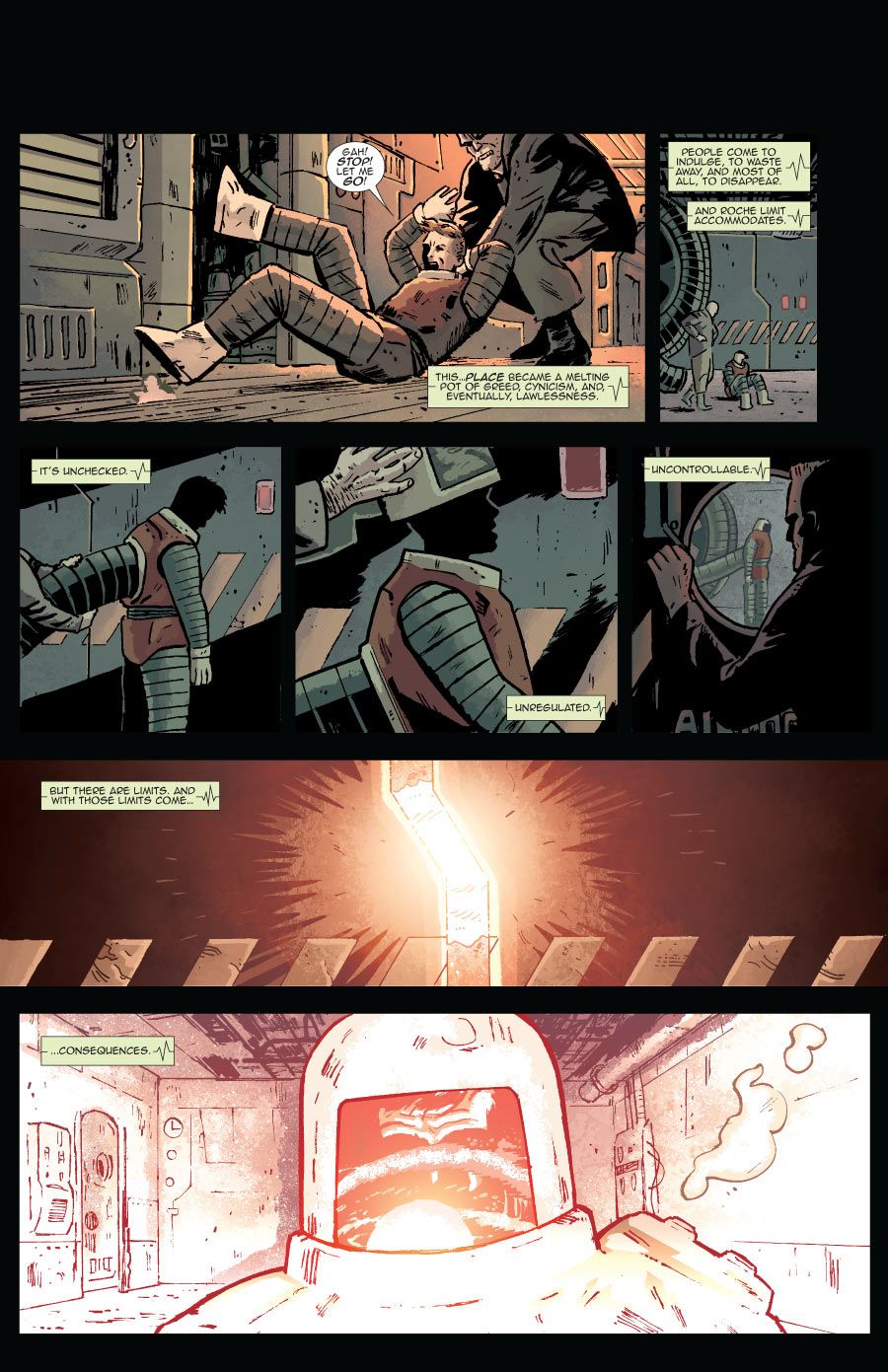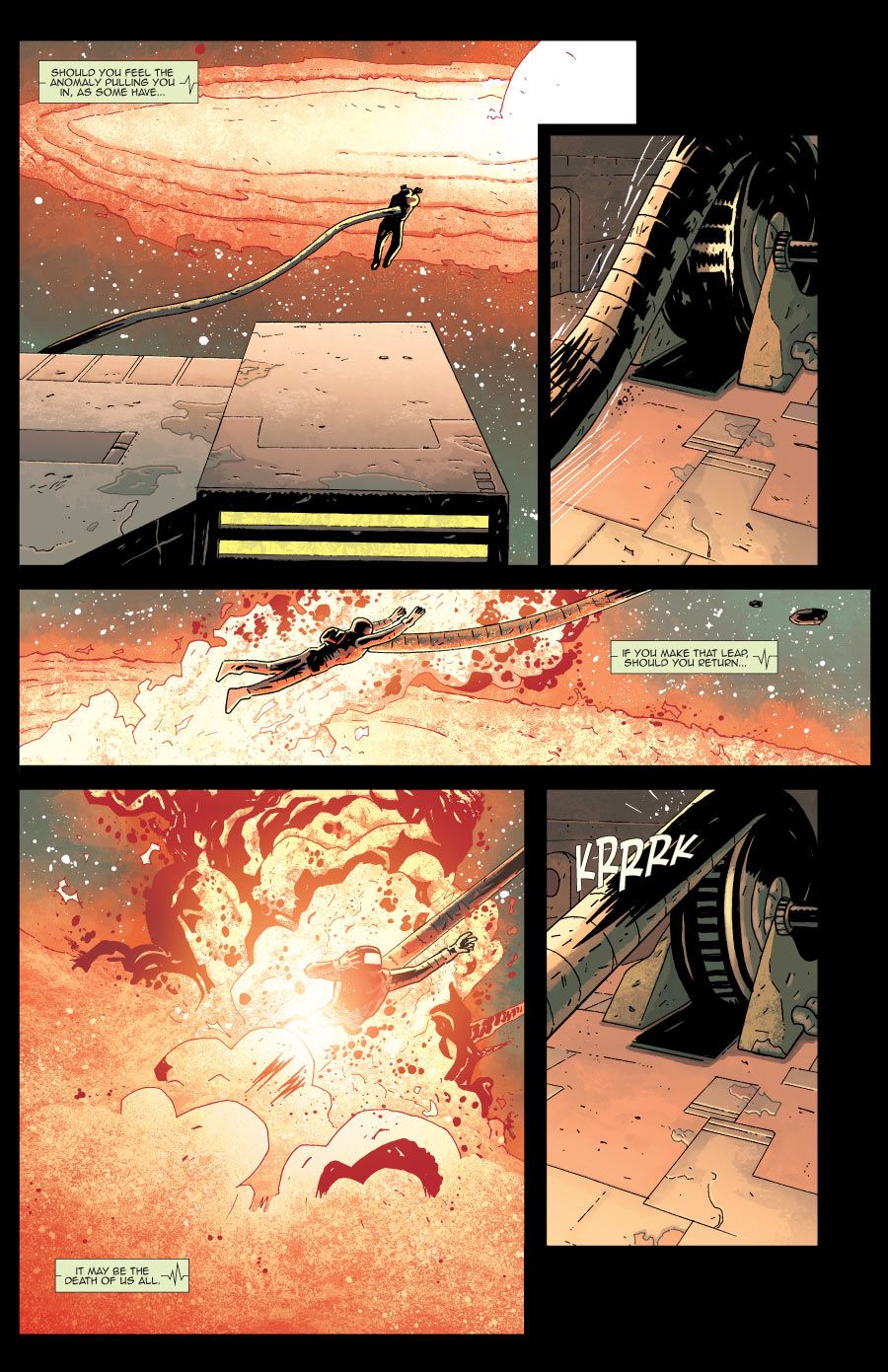French mathematician Edouard Albert Roche was the first to calculate a theoretical limit at which a body, like a planet in orbit, will torn apart by the gravitational force of a larger body. With the tidal forces between the two objects being stronger than the mutual attraction that brought them together in the first place, the orbiting planet is destroyed. With that in mind, imagine: Earth colonizes a planet in the name of exploration and discovery, but twenty years after the bold venture into space, the colony has been shaped into something dark and dangerous. Crime and greed have replaced discovery and innovation, turning this new planet into a station of wasteful indulgence. How long can a place like that self-sustain against the anomalous energies that surround it? And what will become of mankind? Writer Michael Moreci and artist Vic Malhotra explore this trajectory of human evolution in their new sci-fi/noir series, "Roche Limit."
The teasers for the upcoming Image Comics series began popping up months ago, with a compelling color pallete and unique design elements reminiscent of mid-century futurism. The taglines were simple and thought provoking, with two of the teasers acting as promotional materials from fictional companies MoiraTech and Galactic Industries: "Come find us." "The unknown beckons." "The universe awaits." "Come explore with us."
Now that the series has been formally announced, with a release date of September 24, CBR News spoke with Moreci to find out more details on the that he says is the most challenging book he's ever written.
CBR News: Tell me about "Roche Limit." What is the scope of the series and what are you exploring?
Michael Moreci: This is definitely the biggest, most ambitious undertaking of my career. The setup itself is fairly demanding, in that "Roche Limit" is a trilogy. The book will consist of three separate parts, each five issues, and those parts will all take place many, many years from each other. In a way, every volume will be starting from scratch, with new characters and a new plot that will function in specific genres. The stories do link though -- in location because of the "Roche Limit" colony, and also thematically.
Speaking of theme, this is the most challenging book I've written, on that level. The heart of "Roche Limit" is about looking at human evolution, specifically how far we've come -- or, more like how far we've failed to go. The premise is that humanity has pushed its boundaries in space, and we've found a semi-habitable planet (it's a fixer-upper). The man who made it possible to build a colony saw it as a marker in a bold human journey. But, humans are humans. And what happens in the book is a reflection of our inability to cooperate, to get over our greed and power lust and petty bullshit and work toward a common good. If there's anything the Obama years has taught me, it's that people -- Americans, at least -- are totally incapable of banding together to achieve necessary goals. That cynicism, I think, is reflected in this book. Fun, right?
I'm really just looking at the human story -- that's what sci-fi does -- and trying to say something worthwhile about where we've been and where we're headed.
Also, there's a weird energy anomaly hovering above "Roche Limit," and that makes some strange, strange things start to happen.
We've seen a really incredible surge of sci-fi comics lately, especially from Image. What attracted you to the genre?
Strangely enough, "Roche Limit" is nothing like "Black Science" and other titles in that vein. Don't get me wrong, I loooove "Black Science." But, while that's an Al Williamson space romp, my trajectory is more in line with existential sci-fi, stuff like "Gattaca," "Blade Runner," "Stanislaw Lem," even "Nowhere Men." Those movies and books have always been my favorite anything because of their ability to really examine the human soul in context of a recognizable, palatable culture. I've tried, for years and years, to tell a story like that but have always failed. "Roche Limit" is me finally breaking through -- this is the book I've meant to tell since I've wanted to tell stories.
Is your title referring to the actual Roche limit/radius? It seems like there's a metaphor for the principles of self-attraction in a place designed for bougie indulgence like Roche.
Oh, yeah, very much so. The idea of a Roche limit plays a literal role in the book -- it's incorporated with the anomaly and is very important to the story. But there's also that thematic level. A Roche limit is basically about disintegration, coming physically undone. You look at the themes mentioned above, and things falling apart, disintegrating, is what much of the book is about.
And you hit the nail on the head with bougie indulgence -- this upper class of wastefulness. If we really did have this colony on a planet, it would totally become Club Med for the rich, and the opportunity for an outpost of Sagan-ian exploration wouldn't come close to happening.
I'm reminded of something Mike Judge said when describing why he made "Idiocracy." He said something to the affect of: "I see all these futuristic movies with flying cars and clean cities and useful technological advances -- what makes anyone think that's the direction we're headed in?"
It's perfect because we all wonder what the future will be like. The answer is that it'll be a whole like it is now -- and I don't mean that in a good way. I'm not a total cynic, but if this is where we peak as humans in the cosmos, we've failed miserably.
As with your work on "Hoax Hunters," it seems that this new series is very much about a specific world and the rules that apply to it. What is your approach to creating these places that are both familiar and dangerous?
I think Roche is truly its own unique environment, literally. Vic and I have had so many long, thoughtful discussions on what this slum corner of this colony would look like, and the development Vic has done is outstanding. He's building that world the way the people would, using found supplies and materials and piecing it together with DIY architecture and construction. He's putting the pieces of these buildings together, and that's the stuff they're made of. The photo research alone has been crazy.
That, to me, is what makes it frightening; it's closeness to reality. If we had the setting in this already far-off place be some sort of cityscape we hardly recognize, it's just one step further away from our understanding of the world. And since thrills and suspense are most effective when internalized, it's crucial to keep the reader close to this fictional world.
Alex, Sharon and Watkins -- are these your main characters? What can you tell me about them? What is their world like?
I think this is where the pulpy noir elements come in. Alex is a drug manufacturer who, while flawed, is a victim of circumstance and a good person deep down. Sonya is a badass detective from Earth who has come to Roche Limit to find her sister. And Watkins -- that's the man of mystery. He's a doctor and scientist. But the experiments he's conducting -- I can't really spoil it!
Tell me about how you assembled your creative team -- what factors were important to you for the series? How did you connect with your team?
To me, when you're working on a creator-owned book, it's so important that you are working with people who believe in the book. This is a high risk, potential high reward/potential low reward endeavor, and you need people who feel that this story must be told and who are willing to shoulder through if need be. Of course, there's also the question of finding the right fit artistically, and I think this team -- especially Vic and Jordan -- is like peanut butter and jelly. I can't see anyone but Vic creating this world, and Jordan's colors compliment his art in a way that seems like they've been collaborating for years. Add in Tim Daniel's excellent design work and Ryan Ferrier's very effective lettering, and you have one great team. I'm a lucky guy to be surrounded by such talented creators.
Let's talk about the gorgeous graphic design elements we're seeing in the images released so far -- what was your inspiration behind the teasers? How did you collaborate on their design and development?
It's hugely important. I want to build this big world with a real history, and I want it to feel authentic. Also, I wanted to experiment with taking risks in storytelling, specifically filling in those cracks of world building. I didn't want the story to suffer from awkward exposition or weigh things down with unessential scenes that are more about establishing the setting rather than pushing the plot forward. So, we're going to be incorporating a strong design presence into the overall experience of "Roche Limit," online and in the book itself. Every issue will go cover to cover -- we'll have design back matter that further dives into the world and other touches. And the cool thing is that you don't have to read it -- the actual sequential story functions without these articles and graphics and whatnot. I suggest you do read it, though!
Fortunately, Vic, Tim, Jordan, and I are a cohesive unit -- we all understand the aesthetic of the book, so collaborating on this ancillary text works well for all of us. The deeper we all dig, the more effective the world we create. Simulacra is essential to what we're doing, and it has to be seamless. The design element helps greatly with that, and I think it's going to make for a unique, rich, and rewarding reading experience.
Let's break the teaser images down -- in one, we've seen alien-like creatures. Is there extra-terrestrial life in the series?
Hmmm -- sort of? The alien-like creatures we've seen, the trio -- we will see exactly who they are and why they're the way they are. I think once readers learn that, it's going to be one of those "ohhhh, shit!" moments.
Still in your teasers -- what is MoiraTech? And what do they consider "the right choice?"
Well, we saw two competing corporations, MoiraTech and Galactic (Easter egg alert: Moira is Latin for fate). Which is the right choice -- mystery!
I also caught a little blurb on a teaser image warning of side-effects that include night terrors and infections without injury --
Hahaha -- nice catch. Yeah, that's no joke. We'll definitely see this happen to people in the book, and the results are not good. Not good at all.
You pose an interesting statement in the first issue regarding exploration and humanity's destination toward fulfillment. What do you think some of the next steps we should be taking are? And do you feel that our society is moving sideways and not forward, as "Roche Limit?"
Sadly, yeah. I touched on this above, but you really don't have to look too far to see a good number of people who hate and fear the future. If we can't stop kids from getting shot and killed in school, let two people in love get married, or give equal rights across gender -- if we can accomplish these essential things, then we'll all be encumbered by a set of lead boots that keeps us planted to the ground when we could be flying.
Yes, we make incredible technological advances all the time, and it's truly awe-inspiring to look at these accomplishments. But as long as these culture wars rage on, we'll all be limited. We waste so much time and effort fighting each other rather than pulling in the same direction towards improving our society, whatever form that may take. At the risk of sounding like an idealist, imagine if we took the money we've spent on defense spending and the like and put it in schools and healthcare. A world of smart, healthy people -- the things that would happen!
I know I've sounded, let's say, a little bit on the bleak side in disclosing some of the perspectives behind the book. But, within the Roche Limit story is a message of hope -- I wouldn't be so disappointed if I didn't believe we couldn't achieve more. And we that in the book, this tremendous, clever, and selfless human spirit that has the capacity to reach tremendous heights.

